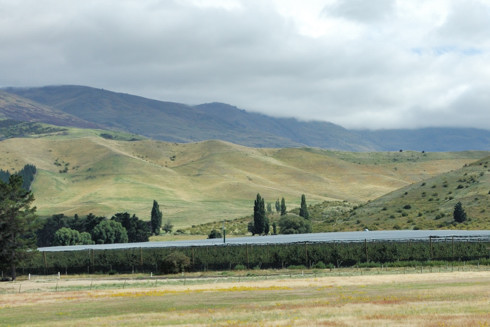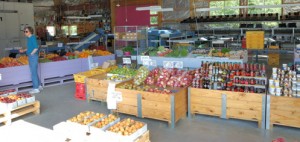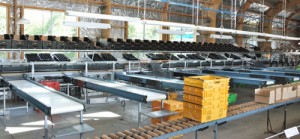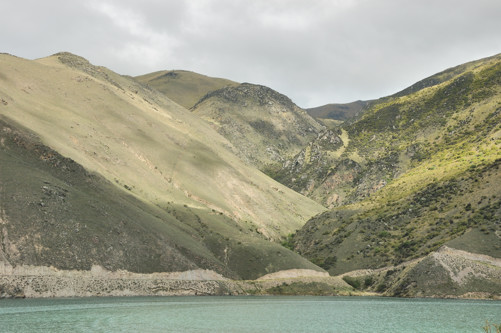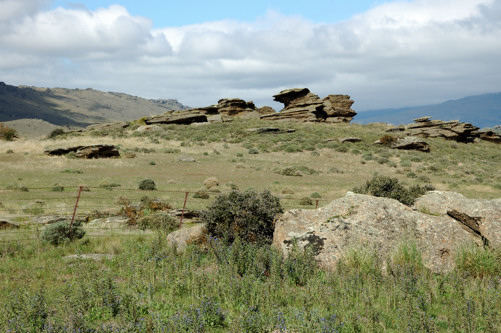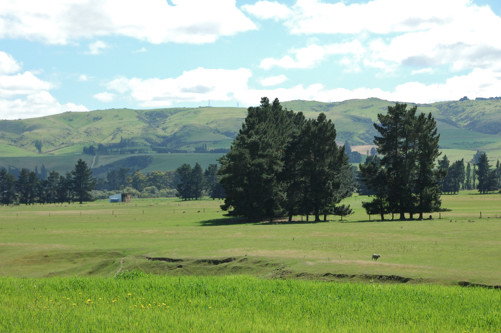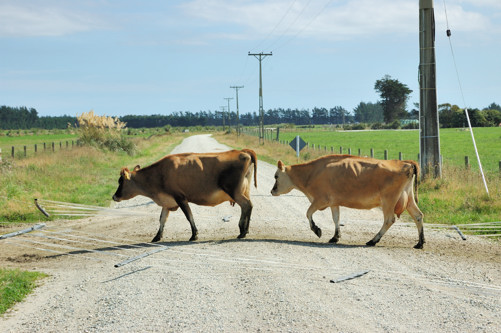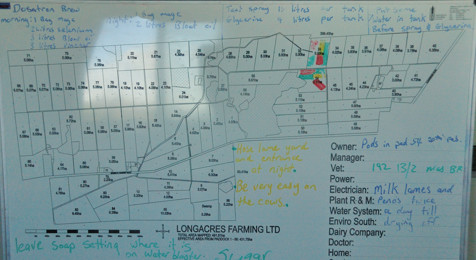After a good night’s sleep recovering from the exertions of the Milford Track, we today drove south to a “farmstay” east of Invercargill in the “Southland.” The first third of the most direct route, would have retraced half of the drive to Te Anu, which we had just done twice, so we elected to head east from Queenstown to Cromwell and then south on Hwy 8 and Route 90 through Gore and then on to where we would be staying 30 km east of Invercargill (and just 5 km north of the south end of the island).
The initial part of this gorgeous drive, through the central part of Otago, was interesting because the land changed dramatically several times. Leaving the mountains of Queenstown, we passed through wine country and then, entering Cromwell, we arrived in the first of two regions of orchards that we would pass through. The photo below shows an orchard of what we believed were cherries completely covered in bird netting.
Like many that we passed, this large operation had several kinds of orchards, and a roadside store like that shown below on the left that, in this case, was the front of a small packing house, shown on the right.
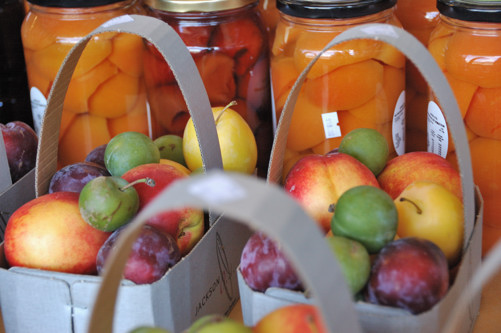
This shows a sample of the fruits that they sold, both fresh and packed.
As we continued further south towards Clyde, we saw rolling hills that clearly got less rain than where we had been.
Then, although not higher, the land became substantially more rocky with large boulders sitting above ground.
Until finally, as we headed south into Gore, the landscape began to flatten out into the fertile, green pastures of the Southland.
Gore is an agricultural town, reminiscent of ones I remember from the states. We had assumed that there would be places to stop for lunch, but when we were ready there seemed to be none until we arrived in Gore about 1:45. Although Gore is a large town, on Saturday all the shops close at 1:00. We felt fortunate that we found a café that was still open for another 15 minutes. The only alternatives at that time appeared to be MacDonald’s and Kentucky Fried Chicken – not what we had travelled to New Zealand to sample. We had an interesting meal in this café, although, because it was almost closing time, they were unable to offer us several choices we might have had. I hand a C.L.T. – chicken lettuce and tomato sandwich – that was shredded chicken mixed with a mildly spicy, pepper jelly served on toast with slices of lettuce and tomato. Nina’s wrap also had jelly on it.
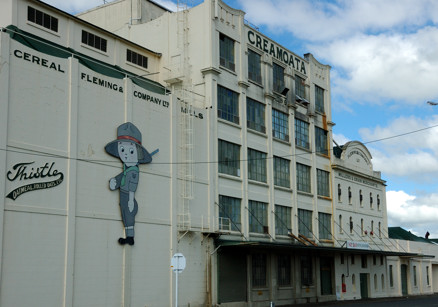
Here is a photo of a flour mill in Gore, which I believe has now been abandoned.
Our farmstay for this and tomorrow night is at the Long Acres farm. We found our way on back roads to within 400 meters of the house when we were stopped by cows walking across the road between temporary electric fencing that had been laid flat across the road.
The cows continued down the land

to a field which already had several hundred in it.
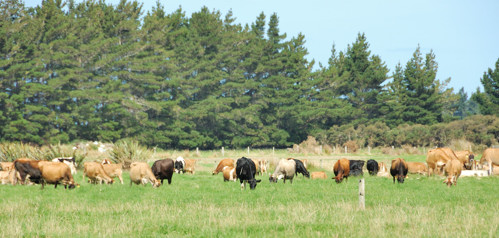
We were not sure if it was okay to drive across this fencing, and there were so many cows in the field that we assumed that the parade would soon end. However, 20 minutes later we were still there when a small truck approached from the other side, simply drove over the electric fencing and stopped. It turned out to be our host Graeme, coming to see if anything was wrong. We expect that the crazy Americans sitting in their car waiting for the cows to pass by will be a source of local mirth for the next month or two. With a little encouragement from Graeme, Nina drove over the fencing – Nina having decided that today was the time to master the stick shift and left-side driving – and we made it to their home where we met Helen.
What we were watching was the larger of their two herds, walking from the milking shed, where they had just been milked, to the pasture where they will spend the night. This is a herd of 1100 Jersey, dairy cows. Their second herd is 500 Holsteins, also dairy cows. Their son took over operation of the farm from Helen and Graeme who, in turn, took over the farm from his father and uncle. He switched from raising sheep to cows two years ago, and is now raising these two varieties to see which will work better for them here. The Jerseys are smaller and give slightly less milk, but also need a lot less food. The Holsteins give more milk, but require more food. Their milk, however, also has a somewhat higher percentage of protein which is important. The milk of the Jerseys, by contrast, has a higher percentage of milk solids which is an important determiner of the price that they receive. Unlike America, where dairy cows are fed a high-protein, grain diet, food for these cows is primarily grass. Now it is fresh, but during the winter, a large percentage will be from dried bales of hay, which they have cut from their meadows, augmented with swedes – what we call rutabagas. As shown in the diagram below, the 1500+ acres of Long Acres farm is divided into 5 hectare fields (a hectare is 10,000 square meters; roughly 2.5 acres). Both herds are milked twice each day and then put out into a new field. Each field is grazed only once every 30 days.
I suppose that there are farmstays in America; however, I have never heard of them. However, they have been a growing trend in Europe at least since the 1980s, particularly in Italy, and are quite popular here in NZ. Helen and Graeme turn out to be friendly, generous, and accommodating hosts, which is important as we are sharing their house with them and a young German couple that arrived later this evening. In some ways, farmstays are like B&Bs with less of a focus on frills and more on the life of a working farm. To that end Graeme took us on a long tour of the farm and he and I had several interesting discussions about the difference between dairy farm practice in America and New Zealand. Although not a necessary part of the arrangement here, we chose to have dinner both nights with Helen and Graeme. Today, dinner was quite a feast with roast lamb and a wonderful assortment of freshly cooked vegetables that Helen prepared. To finish the meal, Helen offered a strawberry dessert that was like a roulade, but, since she knew of Nina’s wheat allergy, with a soft meringue replacing the sponge cake that would be usual. She had a name for this, that, unfortunately, I do not remember.
